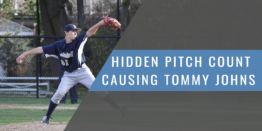| 7 Exercises for Pitchers to Improve Shoulder Strength and Mobility |
| By: Brian Donofrio
Provided by: STACK Look at a minor league starting pitcher coming off a 150-inning season. Obviously, he will have a lot of wear and tear on his throwing arm. It is our job to ensure that he regains proper range of motion and relearns stability in both the glenohumeral joint and scapulothoracic joint to get him moving, feeling and performing better when he begins his off-season throwing program. Some key things we work on to improve function are motion of the scapula along the ribcage and the interaction between the scapula and glenohumeral joint to create efficient, fluid motion around the shoulder girdle. Although proper shoulder function is a big concern of ours during the off-season, we also have many other needs to address and must use exercises that offer a heavy return on investment throughout our programming. Below are some of the best movements we use to integrate proper function and keep our pitchers healthy through the season. WALL SCAP SLIDES Scap Slides help to reintegrate proper scapular motion and scapulohumeral rhythm. Start with the forearms at shoulder height, pressed into the wall with a foam roller or valslide. Stand with a staggered stance, keeping the chest tall with head back and chin tucked. Reach the arms up at a slight angle, coming up as high as you can while keeping a neutral spine, with scapula moving along the ribcage. This exercise is a great way to teach the connection between the scapula and ribs, and it allows athletes to learn how to get into a more efficient overhead position. PUSH-UP TO DOWNWARD DOG This is another great exercise to teach scapular motion. Think about pulling yourself down to the ground with scapula retracted to get to the bottom of the Push-Up. From there, push away from the ground through the hands, reaching out in the top position and forcing full range of motion. Then drive the hips up to make a "V" with your body, reaching overhead at the top of the Downward Dog to work good overhead stability and proper scapular motion going overhead. PUSH-UP POSITION MULTIDIRECTIONAL REACH The first part of this exercise is establishing a strong push-up position, with the head back, chin tucked, chest tall, back flat, core and glutes engaged and toes driving into the ground. We use paper, wrist wraps, towels, etc., to allow a smooth glide while reaching. Maintain a strong push-up position while reaching overhead at a 45-degree angle and laterally. Make sure hips and torso stay square to the ground throughout the exercise, and stay tall to allow the scapula to glide on the ribcage. BEAR CRAWL The Bear Crawl is my favorite exercise for core and scapular stability, while also serving as a great tool to challenge coordination. Start in a quadruped position with chest tall, neck back, chin tucked, back flat, core tight and knees in line with hips. Raise the knees just above the ground, then with opposite arm and leg take a small, controlled step forward. Alternate sides to crawl a specified distance, then move backwards to come back to the start. Y'S/T'S I use Y's and T's to strengthen the lower and middle traps and to teach good stability in an overhead position without the added reference point of the ground. Pull the arm into position through the lower traps to ensure recruiting the right muscles with good movement and not just creating motion at the glenohumeral joint. BAND ROTATOR CUFF CIRCUIT There is a benefit to incorporating isolated rotator cuff work, especially with starters and harder throwers who have worn down the rotator muscles over the long season. We like to incorporate isometric holds, active external/internal rotation and some horizontal abduction exercises. HALF-KNEELING BOTTOM-UP KETTLEBELL PRESS I use this exercise to get the athletes into an overhead position with strength, while forcing recruitment of stabilizers throughout the full range of motion. Start in a half-kneeling position, with chest tall, chin tucked, core tight and hips engaged. Hold a kettlebell bottom-up in the hand opposite the forward leg. Punch straight up overhead while maintaining a good upright position. Control the kettlebell slowly back down and complete the specified number of reps. |







